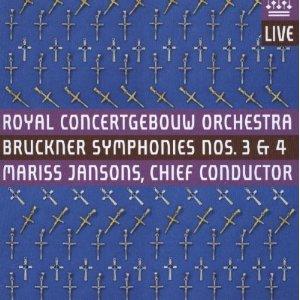Bruckner Symphonies Nos 3 & 4
A powerfully articulated pair of symphonies from the Concertgebouw
View record and artist detailsRecord and Artist Details
Composer or Director: Anton Bruckner
Genre:
Orchestral
Label: RCO Live
Magazine Review Date: 13/2009
Media Format: Super Audio CD
Media Runtime: 0
Mastering:
Stereo
DDD
Catalogue Number: RCO09002

Tracks:
| Composition | Artist Credit |
|---|---|
| Symphony No. 3 |
Anton Bruckner, Composer
(Royal) Concertgebouw Orchestra, Amsterdam Anton Bruckner, Composer Mariss Jansons, Conductor |
| Symphony No. 4, 'Romantic' |
Anton Bruckner, Composer
(Royal) Concertgebouw Orchestra, Amsterdam Anton Bruckner, Composer Mariss Jansons, Conductor |
Author: Richard Osborne
This is particularly evident in the finale of the Fourth Symphony. Though Bruckner spent years trying to get this movement right, it can still sound inadequate in a less than first-rate performance. That is not the case here. Jansons’s grasp of the relative importance of individual ideas within the competing hierarchies of thematic material is as impressive as his marrying of a properly measured opening pulse with a strong yet unforced forward motion. I would have preferred a slightly swifter tempo in the symphony’s processional slow movement, powerfully presented though the journey is. In the main, though, this is a distinguished account of the excellent 1880 version of the Fourth, the introduction of an egregious cymbal clash at bar 76 of the finale notwithstanding.
Though the Third Symphony is less difficult to bring off, particularly in this tidied-up 1889 version, there have been few better-directed accounts on record than this. If there is a limitation, it lies with the Dutch orchestra’s northern manner. Finely as Jansons shapes the polka-cum-chorale in the symphony’s finale, Böhm and the Vienna Philharmonic (10/71 – nla) were even finer. Nor do the horn or bassoon sections of what this magazine has dubbed “The World’s Greatest Orchestra” have the kind of sound characteristics that have helped establish the superiority of Vienna and Munich Philharmonic accounts of the Fourth Symphony under Böhm, Abbado, Celibidache and Kempe.
The horns are further disadvantaged by a somewhat distant recorded balance, unlike that of the cellos which can be too immediate. “Concertgebouw Live” generally gives us a closer, darker sound than that of Concertgebouw recordings made in an empty hall under studio conditions. A striking pair of discs none the less.
Discover the world's largest classical music catalogue with Presto Music.

Gramophone Digital Club
- Digital Edition
- Digital Archive
- Reviews Database
- Full website access
From £8.75 / month
Subscribe
Gramophone Full Club
- Print Edition
- Digital Edition
- Digital Archive
- Reviews Database
- Full website access
From £11.00 / month
Subscribe
If you are a library, university or other organisation that would be interested in an institutional subscription to Gramophone please click here for further information.




